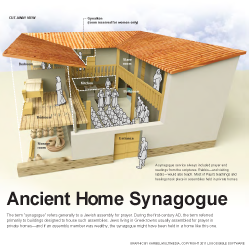16:2 synagogue See note on Matt 4:23.
offering service to God See note on John 15:21.
16:4 because I was with you When Jesus was with His disciples, He was able to guide them; it wasn’t necessary for them to know everything that Jesus teaches in chs. 14–17 (in advance of his departure).
16:7 I will send him to you Jesus is looking ahead to the time when His disciples will carry on His work. When Jesus has gone, the Spirit will become their advocate (see note on 14:26).
16:8 convict the world The Spirit reveals people’s sins and teaches them the ways of God (14:26). Because Jesus’ self-sacrifice atones for sins, people’s sins do not result in death (13:15–17).
righteousness Describes right actions and being in right standing with God.
judgment Refers to the way that God actually judges—He judges based on whether people accept Jesus. The Spirit’s work in the world will be a reminder of Jesus’ previous actions. He will work through believers to accomplish God’s purposes and reveal His power over the powers of darkness and His power to convince people to believe (12:28–50).
16:11 ruler of this world See note on 12:31.
16:12 not able to bear them Jesus has told them information that would be difficult to accept—such as His coming suffering and death and the fact that He won’t be physically present with them after His ascension. He also likely means that they are not yet ready to accept how difficult following Him will be. He has spoken about these challenges in general, but the specifics may be too difficult to hear.
16:14 glorify See note on 13:31.
16:15 Everything that the Father has is mine All of creation came to be through God’s Son, so everything in it belongs to Him (1:1–3). Jesus is also likely suggesting that God’s heavenly abode belongs to Him since He and the Father are one (14:2, 11; 17:11).
proclaim it to you God’s work in the world will become the work of believers. They will be empowered to show people why they should believe and perform signs like Jesus (see note on 14:11).
16:16 see me no more Refers to the time when Jesus dies.
16:20 but the world will rejoice The religious leaders seeking to kill Jesus are equated with the world, which Jesus had portrayed earlier as being opposed to His views (12:31, 36). The religious leaders represent everything that Jesus is opposed to.
change to joy This occurs when the disciples meet Jesus after His resurrection. See note on 14:28.
16:25 figurative Jesus acknowledges that He has used symbolic language to explain God’s work.
16:27 because you have loved me Loving Jesus is like loving the Father, because they are one (14:11; 17:11).
16:28 gone out from the Father See note on 1:1 (compare 1:2–3, 10).
come into the world See note on 1:11; and note on 1:14.
leaving the world Refers to Jesus’ ascension and the work He plans to do in heaven. See note on 14:2.
16:30 you know everything Jesus’ disciples finally answer the question that He has been asking throughout His discourse: whether they are willing to follow Him based on the knowledge that He has shared with them about His death and resurrection (see note on v. 31).
16:31 Now do you believe The fundamental point in Jesus’ message: People must choose to believe in Him.
16:32 scattered When Jesus is persecuted and suffers, they will not stick by Him (compare Matt 26:31). Although some of His followers are there, they eventually all return home.
16:33 peace Jesus wants His disciples to understand that they can be at peace when He suffers and dies. It is the Spirit’s ongoing work to grant peace to believers (see note on John 14:27).
conquered the world Jesus has overcome the powers of darkness (1:5) through His death and resurrection. He proclaims this now because He has already healed people and driven out demons, proving He is able to overpower what people consider unmovable forces. Jesus makes this claim as though it has already happened because He is confident in His prophetic proclamation that He will rise again after suffering and dying for the sins of God’s people.

|
About Faithlife Study BibleFaithlife Study Bible (FSB) is your guide to the ancient world of the Old and New Testaments, with study notes and articles that draw from a wide range of academic research. FSB helps you learn how to think about interpretation methods and issues so that you can gain a deeper understanding of the text. |
| Copyright |
Copyright 2012 Logos Bible Software. |
| Support Info | fsb |
 Loading…
Loading…

